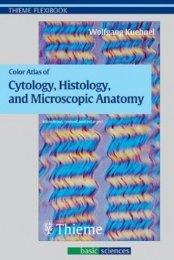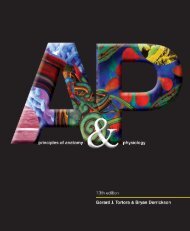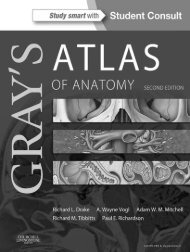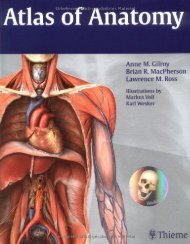urinalysis and body fluids
You also want an ePaper? Increase the reach of your titles
YUMPU automatically turns print PDFs into web optimized ePapers that Google loves.
©2008 F. A. Davis<br />
CHAPTER 2 • Renal Function 17<br />
Tubular Concentration<br />
Renal concentration begins in the descending <strong>and</strong> ascending<br />
loops of Henle, where the filtrate is exposed to the high<br />
osmotic gradient of the renal medulla. Water is removed by<br />
osmosis in the descending loop of Henle, <strong>and</strong> sodium <strong>and</strong><br />
chloride are reabsorbed in the ascending loop. Excessive reabsorption<br />
of water as the filtrate passes through the highly concentrated<br />
medulla is prevented by the water-impermeable<br />
walls of the ascending loop. This selective reabsorption<br />
process is called the countercurrent mechanism <strong>and</strong> serves to<br />
maintain the osmotic gradient of the medulla. The sodium<br />
<strong>and</strong> chloride leaving the filtrate in the ascending loop prevent<br />
dilution of the medullary interstitium by the water reabsorbed<br />
from the descending loop. Maintenance of this osmotic gradient<br />
is essential for the final concentration of the filtrate when<br />
it reaches the collecting duct.<br />
In Figure 2-6, the actual concentration of the filtrate<br />
leaving the ascending loop is quite low owing to the reabsorption<br />
of salt <strong>and</strong> not water in that part of the tubule. Reabsorption<br />
of sodium continues in the distal convoluted tubule,<br />
but it is now under the control of the hormone aldosterone,<br />
which regulates reabsorption in response to the <strong>body</strong>’s need<br />
for sodium (see Fig. 2-5).<br />
Collecting Duct Concentration<br />
The final concentration of the filtrate through the reabsorption<br />
of water begins in the late distal convoluted tubule<br />
<strong>and</strong> continues in the collecting duct. Reabsorption depends<br />
on the osmotic gradient in the medulla <strong>and</strong> the hormone<br />
vasopressin (antidiuretic hormone [ADH]). One would<br />
expect that as the dilute filtrate in the collecting duct comes<br />
in contact with the higher osmotic concentration of the<br />
medullary interstitium, passive reabsorption of water would<br />
occur. However, the process is controlled by the presence<br />
or absence of ADH, which renders the walls of the distal<br />
convoluted tubule <strong>and</strong> collecting duct permeable or impermeable<br />
to water. A high level of ADH increases permeability,<br />
resulting in increased reabsorption of water, <strong>and</strong> a lowvolume<br />
concentrated urine. Likewise, absence of ADH renders<br />
the walls impermeable to water, resulting in a large<br />
volume of dilute urine. Just as the production of aldosterone<br />
is controlled by the <strong>body</strong>’s sodium concentration, production<br />
of ADH is determined by the state of <strong>body</strong> hydration.<br />
Therefore, the chemical balance in the <strong>body</strong> is actually<br />
the final determinant of urine volume <strong>and</strong> concentration.<br />
The concept of ADH control can be summarized in the<br />
following manner:<br />
↑Body Hydration ↓ADH ↑Urine Volume<br />
↓Body Hydration ↑ADH ↓Urine Volume<br />
Tubular Secretion<br />
In contrast to tubular reabsorption, in which substances are<br />
removed from the glomerular filtrate <strong>and</strong> returned to the<br />
blood, tubular secretion involves the passage of substances<br />
from the blood in the peritubular capillaries to the tubular filtrate<br />
(Fig. 2-7). Tubular secretion serves two major functions:<br />
elimination of waste products not filtered by the glomerulus<br />
<strong>and</strong> regulation of the acid-base balance in the <strong>body</strong> through<br />
the secretion of hydrogen ions.<br />
Many foreign substances, such as medications, cannot be<br />
filtered by the glomerulus because they are bound to plasma<br />
proteins. However, when these protein-bound substances<br />
enter the peritubular capillaries, they develop a stronger affin-<br />
Peritubular<br />
capillary<br />
Bowman’s<br />
capsule<br />
Glomerular<br />
filtrate<br />
Tubule<br />
Reabsorption<br />
Secretion<br />
To blood<br />
To urine<br />
Figure 2–7 The movement of substances<br />
in the nephron.

















